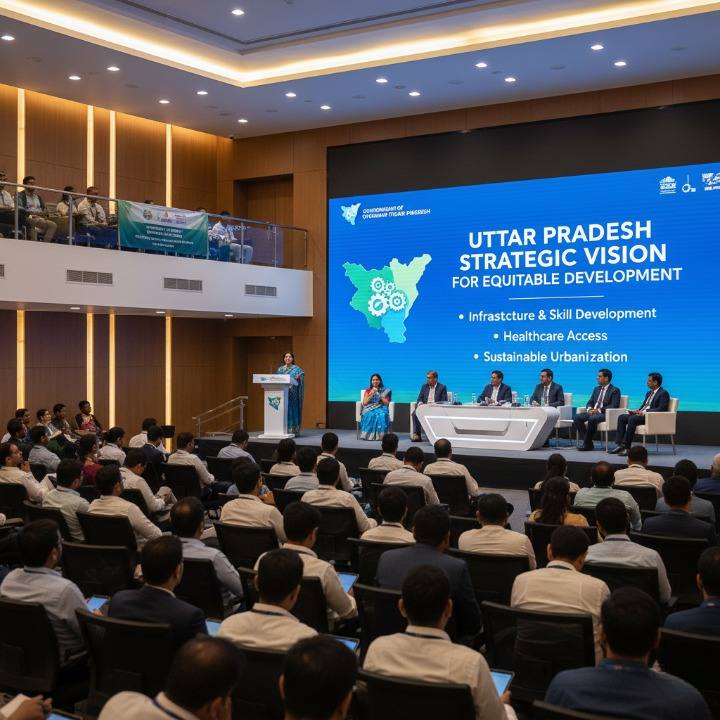Introduction
Uttar Pradesh (UP), India’s most populous state, has embarked on an ambitious journey to transform its economy while ensuring that growth reaches every corner of its diverse demographic. With a focus on infrastructure, industrial development, and skill enhancement, the state aims to create opportunities for all, bridging regional and social divides. But can these initiatives truly drive inclusive growth? This article examines UP’s government strategies and their potential to foster equitable development.
Key Government Initiatives Driving Inclusive Growth
1. Regional Development Through Infrastructure
UP is addressing regional disparities by investing heavily in infrastructure across underserved areas.
- Key Projects:
- Purvanchal Expressway: Connecting Lucknow to eastern UP, fostering trade and access to opportunities.
- Bundelkhand Expressway: A transformative project for one of the state’s most underdeveloped regions, expected to boost industrial activity.
- Impact:
- These projects are creating jobs during construction and paving the way for long-term economic integration of marginalized regions.
(Source: UP Expressways Industrial Development Authority)
2. Focus on Local Industries Through ODOP
The One District One Product (ODOP) initiative supports regional artisans and entrepreneurs by promoting traditional crafts and industries.
- Key Achievements:
- Chikankari embroidery, Banarasi silk, and Firozabad glassware are gaining global recognition through targeted marketing and financial support.
- ODOP products accounted for exports worth ₹1.56 lakh crore in 2022.
(Source: Ministry of Commerce and Industry)
3. Skill Development for Workforce Inclusion
UP’s government recognizes that a skilled workforce is essential for inclusive growth.
- Initiative:
- Skill Development Mission: Trains youth in high-demand sectors like IT, manufacturing, and logistics, especially in rural areas.
- Impact:
- Over 1 million individuals have been trained, with a focus on marginalized groups, including women and economically weaker sections.
(Source: UPSDM)
4. Empowering Women Entrepreneurs
To promote gender equity in economic participation, the government offers incentives and tailored programs for women entrepreneurs.
- Key Policies:
- Additional subsidies for women-led startups under the Startup Policy 2020.
- Training programs to help women artisans under ODOP.
(Source: UP Startup Portal)
5. Affordable Housing and Urban Development
The Pradhan Mantri Awas Yojana (PMAY) and Smart Cities Mission are transforming urban and semi-urban areas, ensuring access to housing and basic amenities.
- Example:
- Smart Cities initiatives in Kanpur and Varanasi focus on affordable housing, digital infrastructure, and green public transport.
(Source: Smart Cities Mission)
Challenges in Achieving Inclusive Growth
1. Regional Disparities
Despite progress, regions like Bundelkhand and Purvanchal still lag behind in infrastructure and industrial development.
2. Social Inequities
Certain marginalized groups, including women and economically weaker sections, face barriers in accessing education, employment, and entrepreneurship opportunities.
3. Environmental Sustainability
Rapid urbanization and industrialization pose environmental challenges that can undermine long-term inclusive growth.
4. Awareness and Accessibility
Many beneficiaries remain unaware of government schemes or face bureaucratic hurdles in accessing them.
Strategies to Strengthen Inclusive Growth
1. Focused Regional Interventions
Targeted incentives and infrastructure projects in underdeveloped regions can address disparities and integrate them into the broader economy.
2. Digital Literacy and Access
Expanding digital infrastructure and promoting e-literacy can connect rural and semi-urban populations to opportunities in education, healthcare, and e-commerce.
3. Expanding Women-Centric Programs
Scaling up initiatives for women entrepreneurs and workforce participation can significantly boost gender equity.
4. Environmental Sustainability
Adopting green technologies and renewable energy in industries and urban projects can ensure sustainable development.
Opinionated Yet Balanced Perspective
Uttar Pradesh’s inclusive growth agenda is commendable, with targeted initiatives like ODOP, expressways, and skill development programs demonstrating significant potential. However, achieving true inclusivity will require addressing deep-seated regional and social inequalities. The government must ensure that its policies are not just ambitious but accessible and adaptable to local needs.
Conclusion
The future of Uttar Pradesh hinges on its ability to turn inclusive growth from a vision into a reality. With sustained focus, collaborative governance, and strategic interventions, the state has the opportunity to emerge as a model for equitable development in India. By ensuring that growth reaches every region and demographic, UP can unlock its full economic potential while uplifting millions.


Leave a Reply